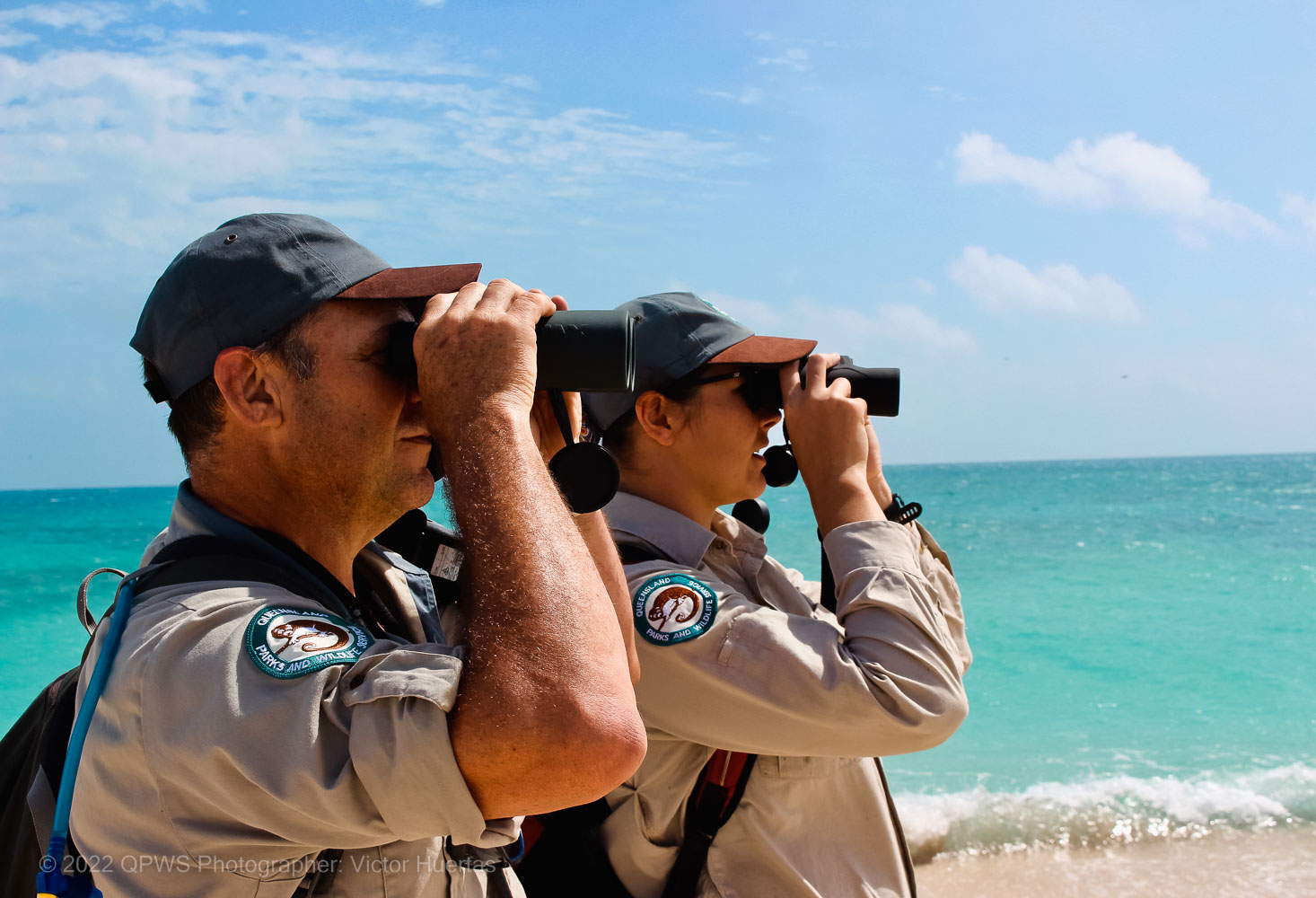The Great Barrier Reef is home to six of the world’s seven species of marine turtle and holds globally significant nesting and foraging areas for greens, loggerheads, hawksbills and flatbacks. Marine turtles play an important role in maintaining the health of the marine ecosystem, providing ecological services such as herbivory and seagrass dispersal, nutrient cycling and sediment production. They also help to sustain the overall balance of the Reef ecosystem, supporting a variety of other marine life. Marine turtles are highly valued by visitors to the Reef, local coastal communities and Traditional Owners, who hold deep knowledge about turtle life cycles and their role within the marine environment.
Green turtles (Chelonia mydas) in the northern Great Barrier Reef are facing a range of significant challenges, with decades of research and monitoring at key nesting sites indicating a possible decline in the population. Raine Island, the world’s largest green turtle rookery, accounts for approximately 90% of nesting for northern green turtles. However, despite intensive conservation efforts, it has seen continued low hatchling production, leaving this population highly vulnerable to localised threats and raising questions around the sustainability of the stock. A critical factor in this decline is climate change. Rising air and sand temperatures are leading to a predominance of female hatchlings, known as ‘feminisation’, which is expected to lead to a scarcity of adult males in the future and potential reproductive collapse. Climate change also threatens essential reproductive habitats, as rising sea levels put nesting beaches at risk. At Raine Island, habitat loss and nest inundation have led to reduced nesting and hatching success, meaning fewer hatchlings are being produced. Observed low recruitment rates of juvenile turtles into key foraging areas suggests that, even with protected nesting sites, not enough juveniles are reaching foraging grounds to sustain a viable population.
Objectives
The Great Barrier Reef Green Turtle Research Program was created to help inform better management and conservation strategies for the northern green turtle population in response to ongoing threats from climate change. This is a five-year, $5.93 million research program funded by Reef 2050 through the Australian Government’s Reef Trust that aims to provide a scientific foundation for targeted conservation actions that can protect both turtle populations and the ecosystems they support. This project is being implemented by the Reef Authority, Queensland Parks and Wildlife Service’s Threatened Species Operations Team and Reef Traditional Owners. The primary goals of the Program are:
- Understand Population Dynamics: We aim to fill critical information gaps regarding the northern Great Barrier Reef green turtle population. This includes understanding the long-term impacts of low hatchling success and increased feminisation of hatchlings at Raine Island.
- Identify Effective Management Strategies: The Program will explore management actions that can be used to mitigate the impacts of climate change, such as methods to cool turtle nesting beaches.
- Enhance Co-Management with Traditional Owners: Working closely with Traditional Owners of the Reef and Torres Strait, we aim to help build capacity for managing sea country through participation in research and knowledge sharing. The Program will integrate Traditional Ecological Knowledge (TEK) and foster collaboration with Indigenous rangers and communities to manage and conserve turtle populations.
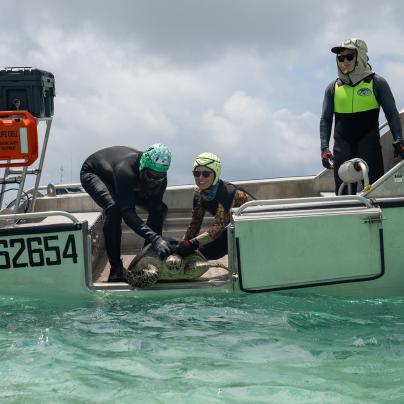
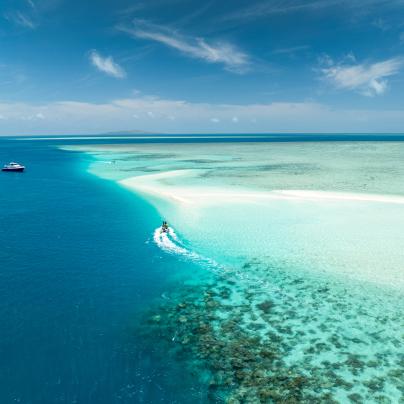
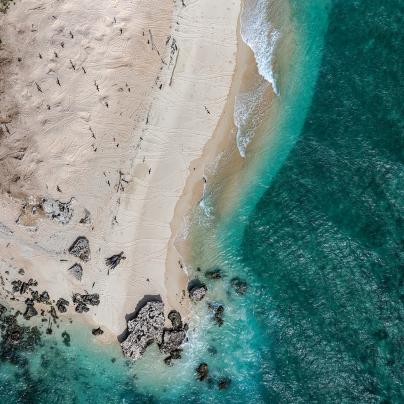
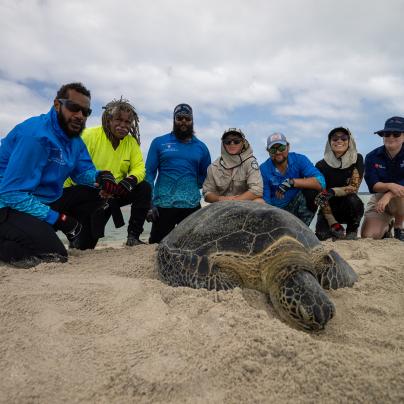
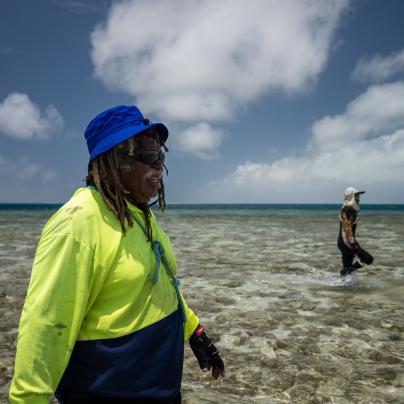
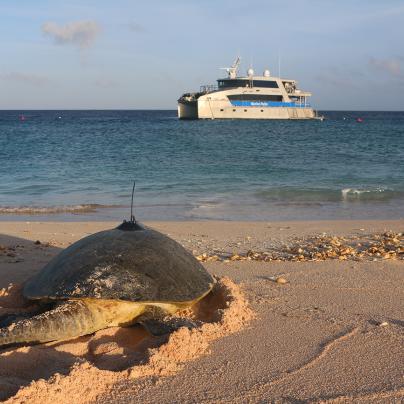
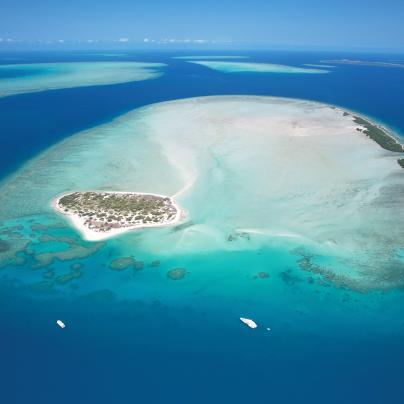
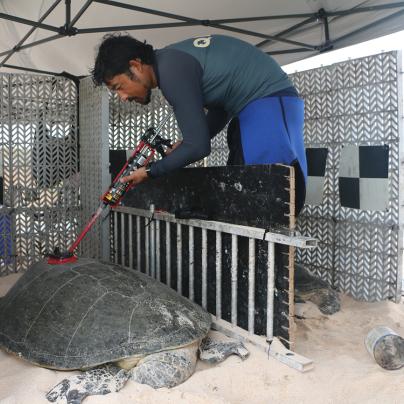
Delivery
This multi-faceted research program is being delivered through five key projects, each designed to address different aspects of the green turtle conservation challenge:
- Nesting Beach Surveys: Aerial surveys will provide important data on the distribution and abundance of green turtle nesting sites across the northern Great Barrier Reef and Torres Strait. These surveys will help track changes in nesting distribution and identify key areas for protection.
- Foraging Ground Monitoring: We will monitor foraging grounds in the northern Great Barrier Reef and Torres Strait to understand the population structure, sex ratio, recruitment rates, and annual abundance of the northern green turtle stock.
- Male Satellite Tagging: This project will track adult male green turtles using GPS satellite telemetry to study their movement and habitat use during foraging, breeding migrations, and courtship.
- Nest Cooling Methods: We will test various methods to cool turtle nesting beaches, including artificial rain and shade, and natural shade from vegetation. Techniques will be evaluated for their effectiveness in improving incubation success and creating a balanced sex ratio.
- Extension and Outreach: We will engage and share results from the Program with local communities, Traditional Owners, and stakeholders, helping build support for local turtle conservation efforts.
Background
Raine Island, the largest remaining green turtle rookery, along with Moulter Cay, supports approximately 90% of the northern green turtle nesting population. However, research conducted over the last two decades suggests that Raine Island may not be producing enough hatchlings to sustain a viable population. While management strategies implemented through the Raine Island Recovery Project have helped to improve nesting success, concerns remain about the sustainability of the population. It is critical that we understand the broader distribution and abundance of northern green turtle nesting outside of Raine Island in order to support effective conservation and management efforts for this species.
Objectives
The aim of this project is to capture comprehensive data on the relative abundance and distribution of green turtle nesting in the northern Great Barrier Reef and Torres Strait. Over two seasons (2020/21, 2024/25), the project will conduct broad-scale aerial surveys of potential nesting beaches during peak nesting periods to:
- Collect spatial data on the distribution and relative abundance of green turtle nesting across the northern Great Barrier Reef and Torres Strait.
- Identify sites with high nesting abundance or density, along with potential refugia (i.e. sites with suitable nesting habitat that are currently underutilised but could support nesting in the future).
- Examine changes in the extent and distribution of green turtle nesting in comparison to previous records to assess any shifts in nesting patterns.
- Capture data on the topography of key nesting sites, which could impact the availability and suitability of nesting habitats.
Delivery
Surveys will be conducted using aerial photogrammetry, a technique that allows for large-scale, high-accuracy data collection with minimal observer error. Unlike traditional manned aerial surveys, this method permits detailed post-flight analysis, ensuring all nesting attempts are accurately recorded and species identification is refined. This method has proven effective in the past for monitoring turtle populations and nesting activities and is especially useful when surveying remote regions or when covering a large geographic area.
Surveys will also capture high-resolution topographic data on nesting sites, including areas of sand, vegetation and beach rock. This, in turn, will be used to estimate the potential nesting area available for green turtles. Information will also be provided on beach profile and elevation which, if future surveys were to occur, could give insights into geomorphic changes over time, such as changes in island size, sand volume, and vegetation coverage.
Surveys will cover all potential nesting beaches north of Princess Charlotte Bay and in the Torres Strait and will be timed to coincide with peak nesting periods to ensure a representative sample of nesting effort for the population. This will allow for a more contemporary understanding of green turtle nesting patterns in the region, which has not been surveyed since 1999.
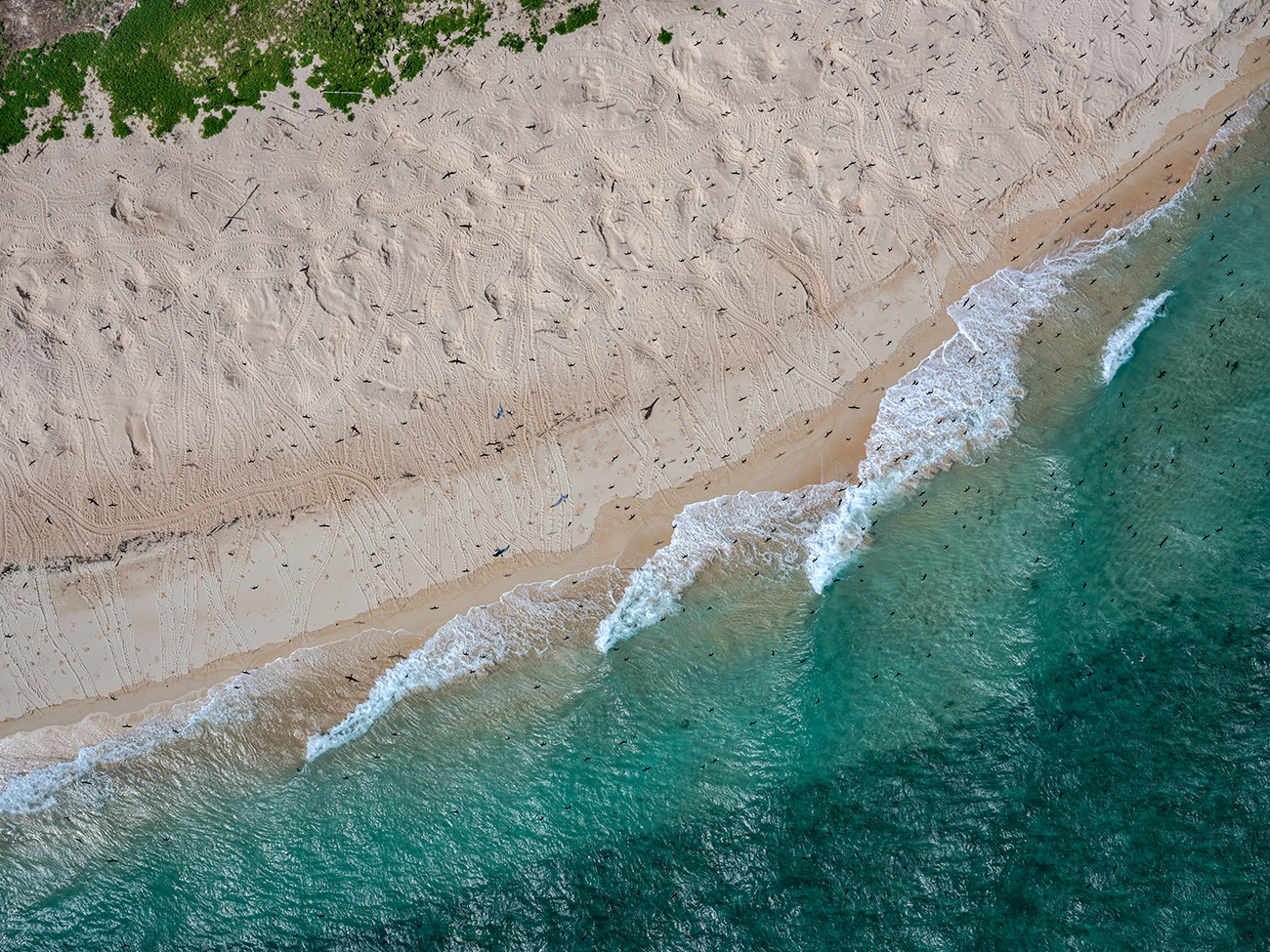
Background
Habitat loss and rising sand temperatures due to climate change are the most immediate and broad-scale threats to green turtles. Hatchling sex is determined by temperatures experienced during incubation, with warmer nests linked to predominately female clutches. This phenomenon is known as ‘feminisation’ and is predicted to lead to a scarcity of adult males in the future, which could lead to reproductive failure and population collapse. Additionally, there have been reports of a decrease in the size of nesting turtles, increases in non-breeding periods, a lack of expected turtle numbers at feeding grounds and more frequent flooding of nests due to rising sea levels. Collectively, these reports indicate that the long-term sustainability of green turtle populations in the region is under threat, and there is a need to better understand the current population structure to predict what this stock may look like in the future.
Objectives
This study aims to determine the abundance, structure and trajectory of the northern green turtle population at selected foraging ground sites within the northern Great Barrier Reef and Torres Strait. Results from this study will help determine whether the recruitment of juvenile turtles to northern reefs is being impacted as a result of low hatchling production and feminisation of hatchlings at Raine Island, the key rookery for this population.
Delivery
Surveys will be conducted using Capture-mark-recapture, a common method used to monitor marine turtle populations. Over three years, a representative sample of the green turtle population at study sites in both the northern Great Barrier Reef and Torres Strait will be captured, tagged and released. Information will also be collected on size, sex and weight of turtles, and samples collected for diet and genetics analysis.
Fieldwork will be delivered in collaboration with First Nations communities within whose sea country this work takes place: the Kuuku Ya’u Traditional Owners and the Meriam Nation Traditional Owners of the eastern Torres Strait (Ugar, Mer and Erub). Through active participation in research and knowledge sharing, this project hopes to foster a collaborative approach to sustainable turtle conservation in the region.
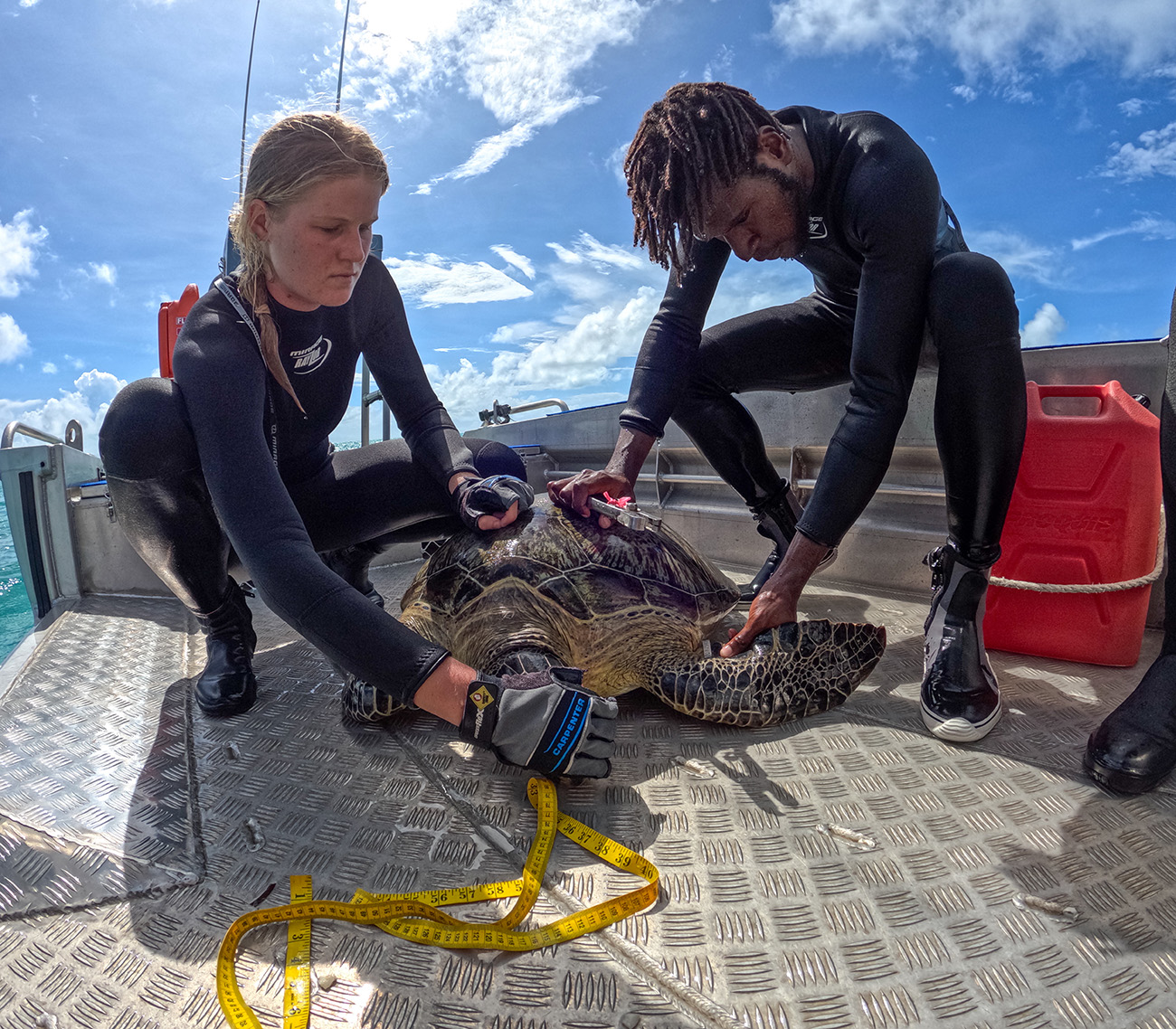
Background
The first step of conservation management is to understand where, when, and how animals use their habitats. For adult male turtles, key habitats are foraging and courtship areas, and migration corridors. Although some habitats are known by managers, many key habitats for green turtles (Chelonia mydas) and how and when they use these habitats are yet to be identified. And while much is known about the migration and breeding patterns of adult female turtles, the spatial ecology of adult males remains poorly documented. Based on flipper tag recovery data and existing published reports, northern male green turtles are likely distributed over many thousands of km² where little information is available.
Given the documented low hatchling production and skewed (female-biased) sex ratios at key nesting sites for northern green turtles, it is critical that males are given comprehensive protection as a conservation priority. Identifying the distribution and habitat use of adult male green turtles during courtship, migration and foraging, as well as understanding potential threats to these key habitats, is essential for effective conservation management of remaining males.
Objectives
This project aims to examine the distribution (spatial and temporal) and habitat use of breeding adult male northern green turtles during courtship and foraging periods and when migrating to and from these key habitats, along with any potential threats.
Delivery
GPS satellite tags will be used to gather crucial data on the movements and habitat use of breeding adult male turtles. This technology offers high accuracy and global coverage, allowing researchers to track these turtles regardless of how far they move after tag deployment. Anecdotally, the major courtship areas for northern green turtles are in the Torres Strait, with additional courtship activity observed near Raine Island. While Raine Island is the largest rookery for this species, the abundance of courtship activity observed there is insufficient to account for the vast number of adult females that nest there, implying that key courtship areas lie elsewhere. Tags will be deployed just before or during the courtship period in early October, targeting adult males from the northern Great Barrier Reef and Torres Strait, believed to be part of the northern population.
Fieldwork will be delivered in collaboration with First Nations communities within whose sea country this work takes place: the Kuuku Ya’u Traditional Owners and the Meriam Nation Traditional Owners of the eastern Torres Strait (Ugar, Mer and Erub).
Background
Four species of marine turtle breed within the Great Barrier Reef region, including the endangered Pacific Loggerhead and Hawksbill turtle, and the Green Turtle and East Australian Flatback turtle, both of which are currently listed as ‘Vulnerable’ under the Queensland Nature Conservation Act. Climate change is threatening marine turtles, particularly in the northern Great Barrier Reef, by increasing the temperature of nesting beaches, which reduces male hatchling numbers and leads to higher mortality rates among embryos and hatchlings due to heat stress. Optimal hatching occurs at temperatures between 26°C and 31°C, while temperatures above this range can reduce hatching success or skew the sex ratio towards females, a phenomenon known as ‘feminisation’. This is because like most reptiles, sex of marine turtle hatchlings is determined by nest temperatures during incubation: warmer nests produce mostly FEMALE hatchlings while cooler nests produce mostly MALE hatchlings.
Given growing evidence that climate change is reducing hatching success and leading to excessive feminisation in some marine turtle populations, including the northern Great Barrier Reef green turtle population, there is an urgent need to address the warming of nesting beaches, particularly in far north Queensland.
Objectives
This project aims to explore large-scale methods for cooling turtle nesting beaches to temperatures that support high hatching success and balanced hatchling sex ratios.
Delivery
Artificial cooling trials will be conducted along nesting beaches near the Queensland Parks and Wildlife Service’s Mon Repos Research Facility on the southern Great Barrier Reef, which has the infrastructure to support both experimental trials and long-term nest monitoring. Three specific methods will be tested: artificial rain, artificial shade and natural shade from dune vegetation. Each approach will be assessed for its effectiveness in manipulating sand temperatures to achieve optimal incubation conditions across large areas of nesting beach and for large numbers of clutches.
Although loggerhead turtles are the dominant species in this region, outcomes from these trials will be used to inform potential beach cooling strategies at northern green turtle rookeries, helping to mitigate the impacts of climate change on northern Great Barrier Reef green turtle populations.
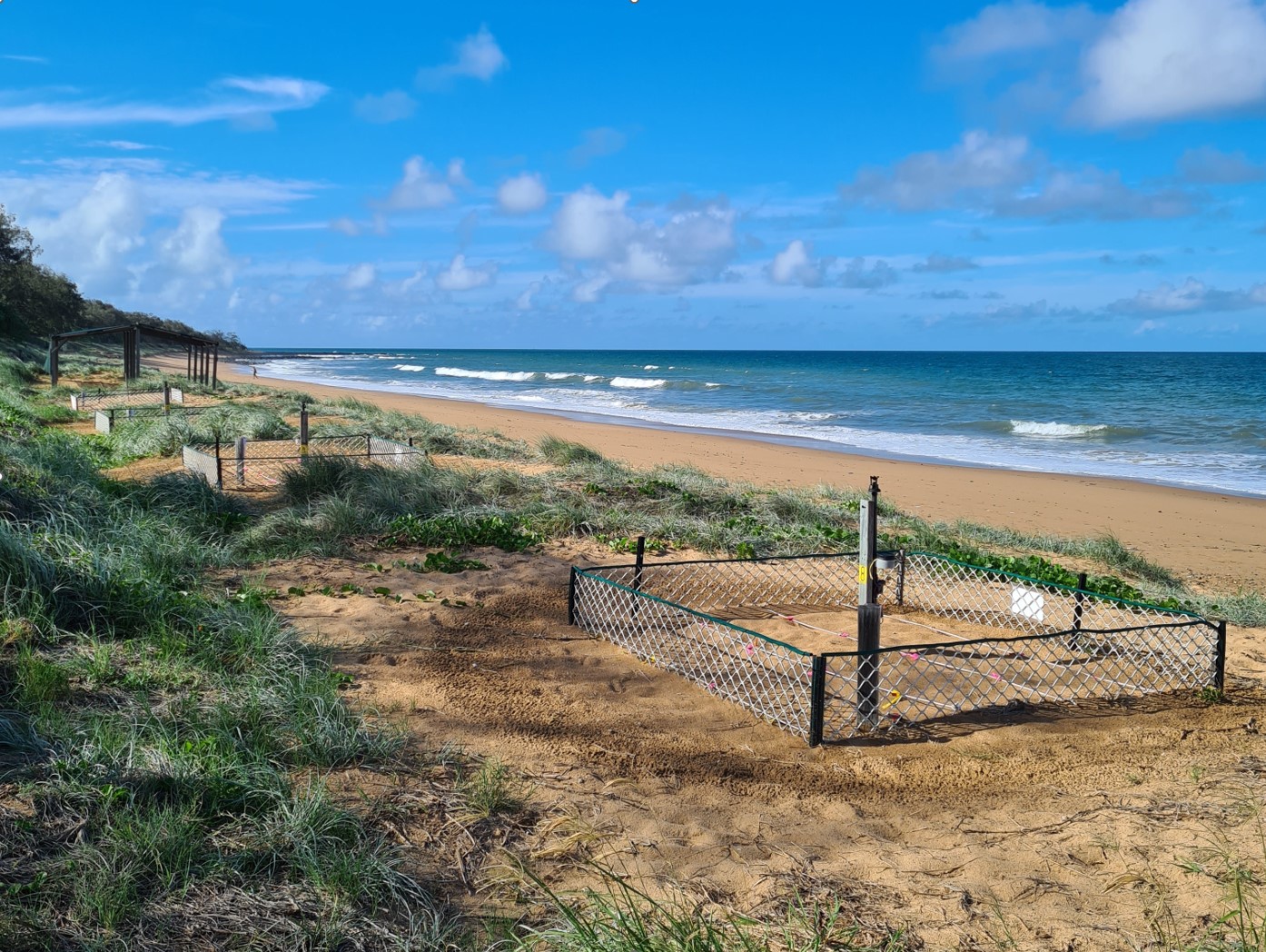

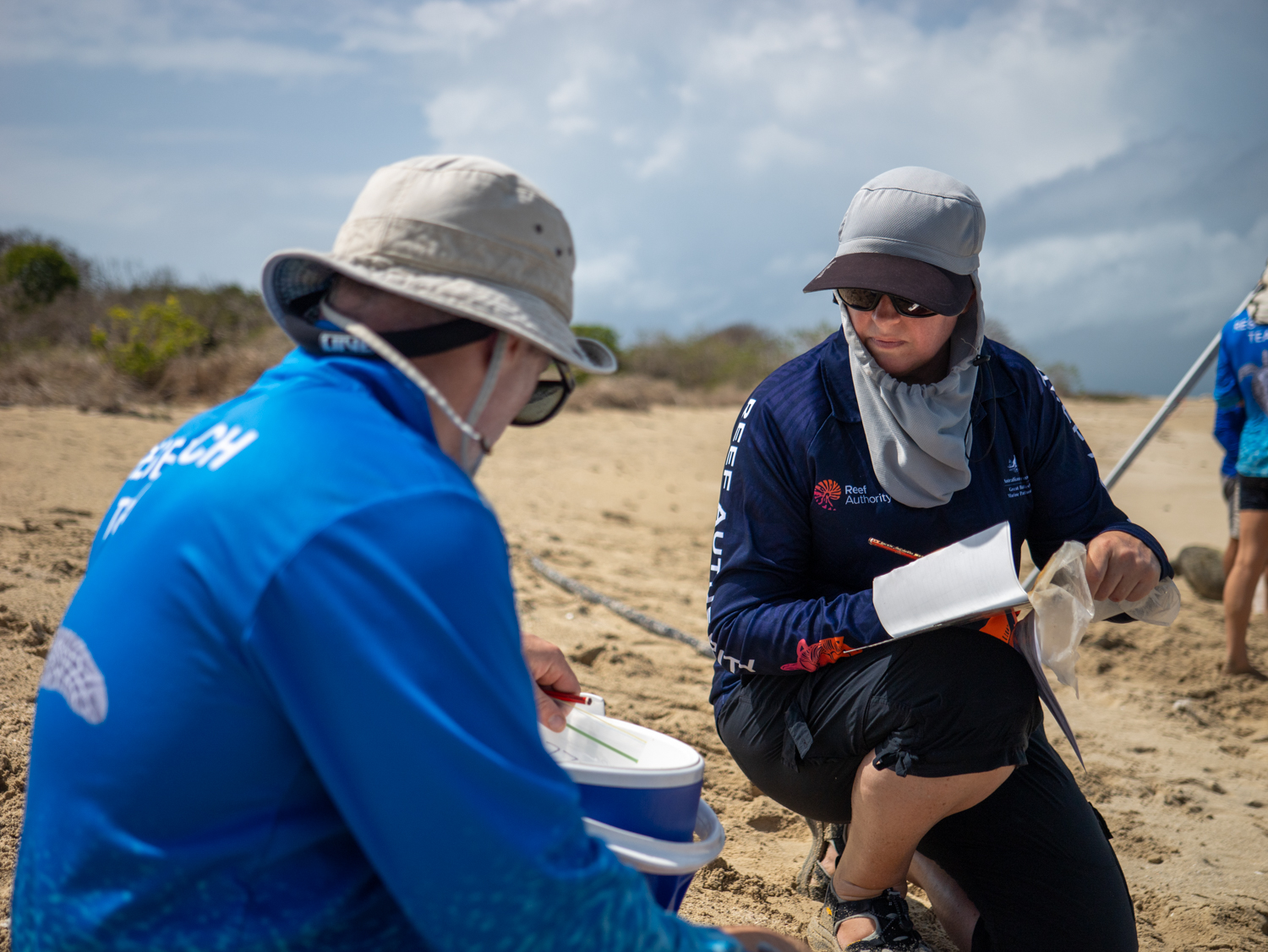
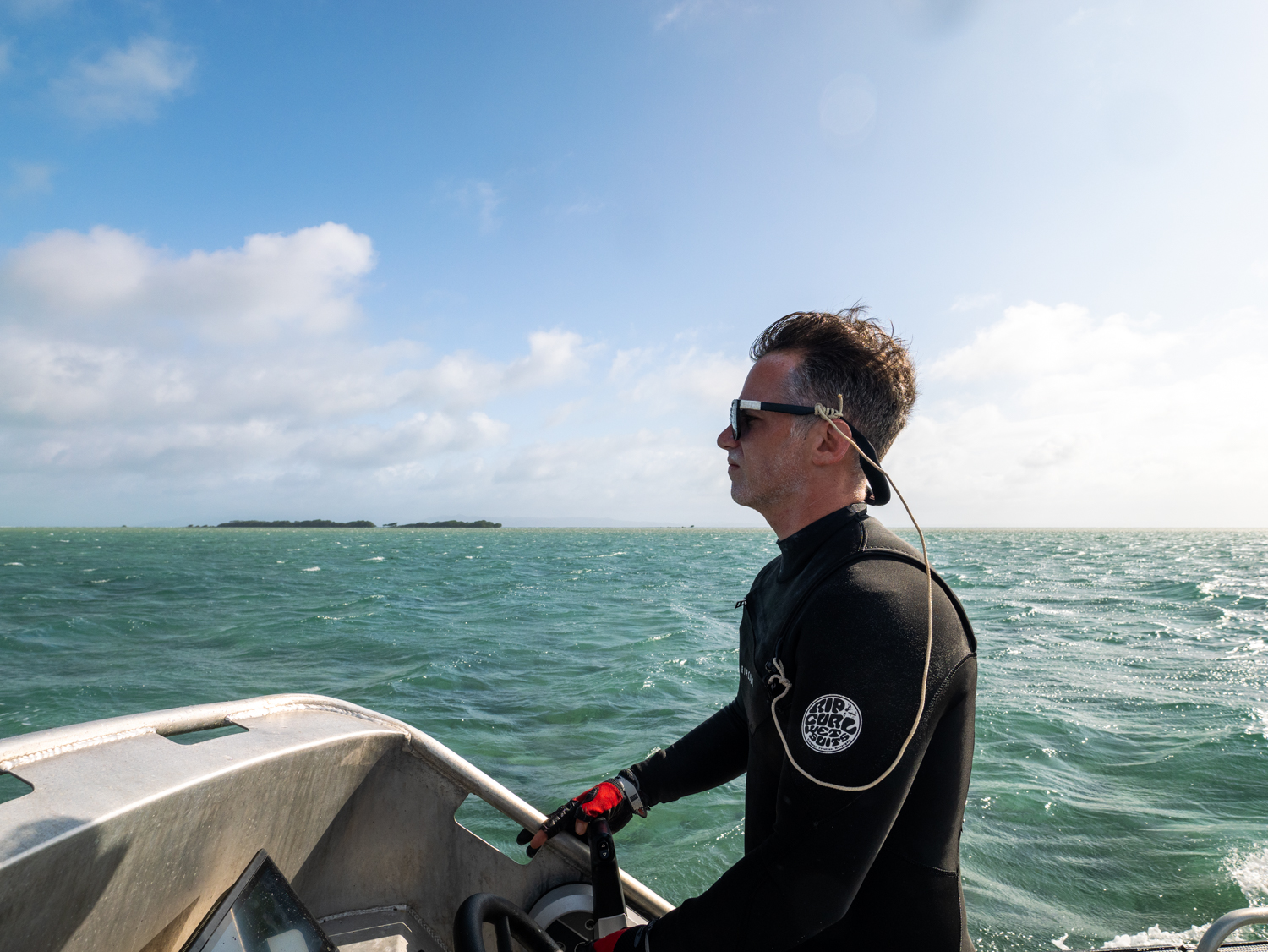
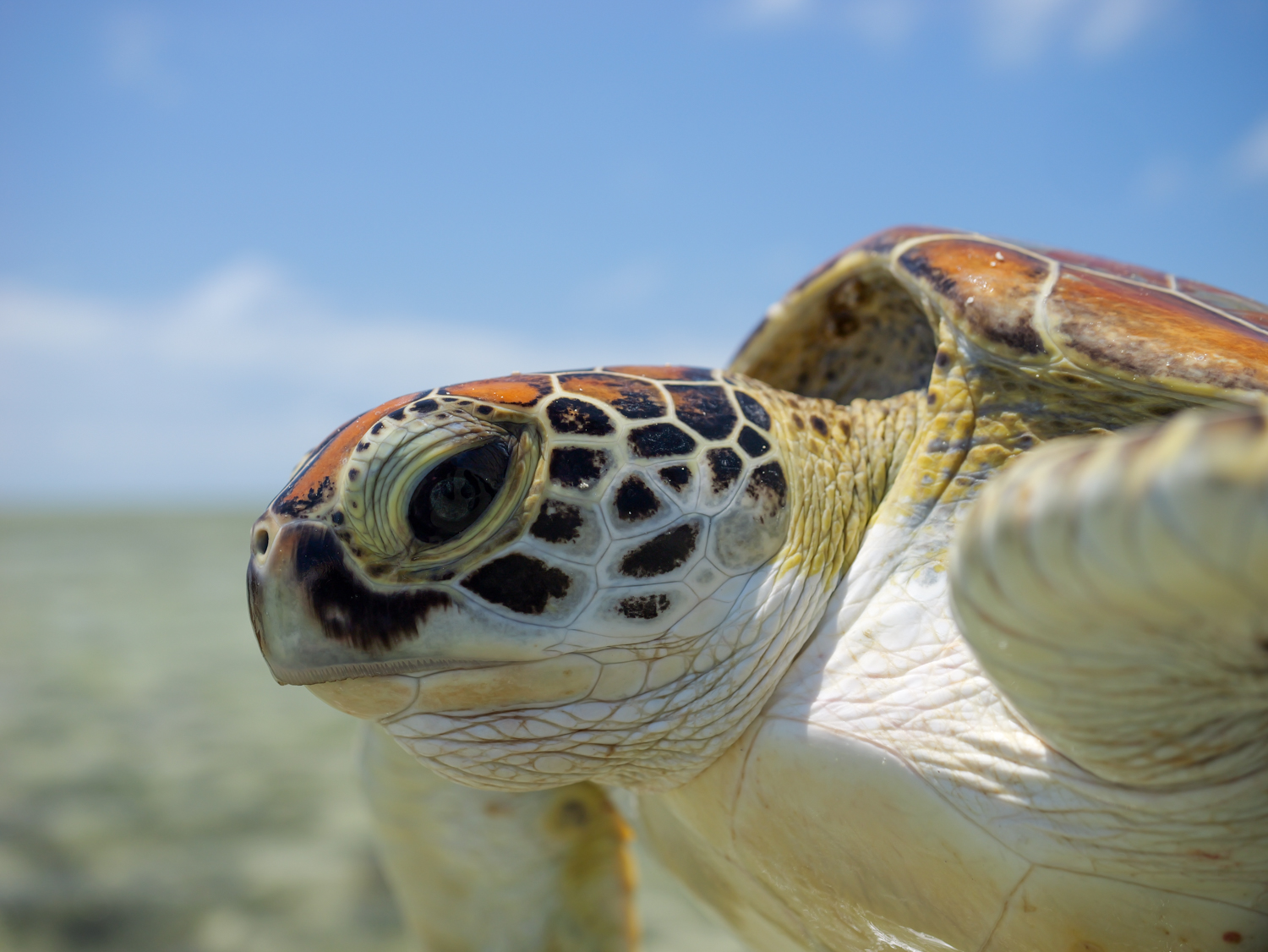
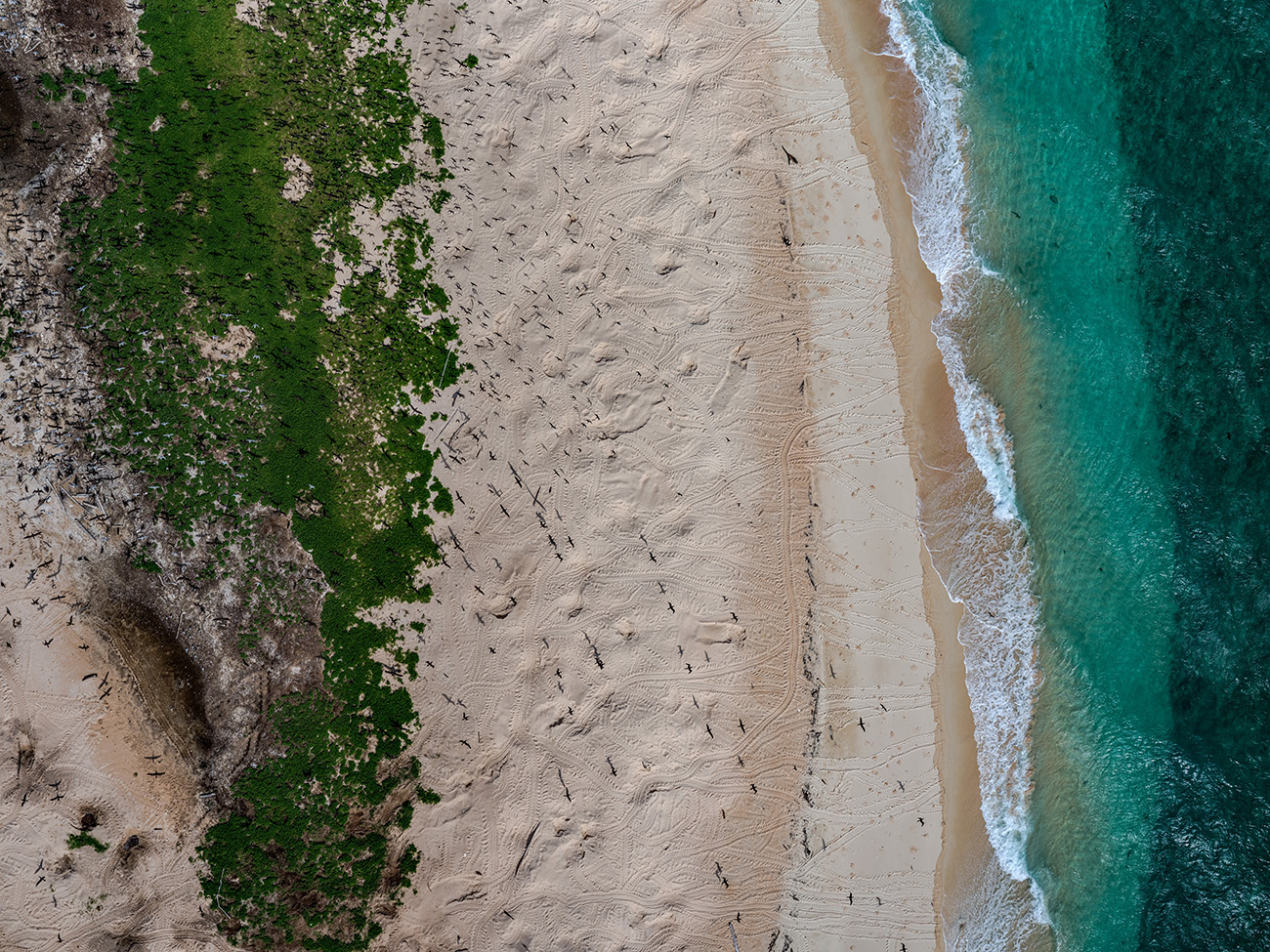
Outcomes
This research program will not only guide conservation efforts for the northern green turtle population but will also have broad, positive effects on the local community and the management of marine ecosystems. The Program aims to generate critical data to support effective management actions to help ensure the long-term health of the northern Great Barrier Reef green turtle population. Key outcomes include:
- Updated Data on Nesting Distribution and Potential Refugia:
The Program will provide up-to-date insights into the distribution and abundance of the northern Great Barrier Reef green turtle population. It will also identify nesting beaches that could become important refugia in the face of climate change, offering new areas for turtles to nest as environmental conditions shift. - Comprehensive Demographic Data:
The Program will provide valuable demographic data, including annual abundance, survivorship, sex ratios and genetic composition of the northern Great Barrier Reef green turtle population at key foraging grounds. This will help assess the sustainability of the population, ensuring that management actions are based on a sound understanding of population dynamics. - Mapping of Courtship Areas and Breeding Migration Corridors:
The identification of courtship areas, migration pathways, and foraging grounds for breeding adult male green turtles will deepen our understanding of their life cycle and habitat use. Data will help inform future conservation efforts to protect these key areas, ensuring that both male and female turtles have safe environments to breed and forage. - Testing Nest Cooling Techniques:
The Program will evaluate methods to artificially cool turtle nesting beaches to temperatures that support high incubation success and maintain a balanced hatchling sex ratio. Outcomes from nest cooling trials will provide valuable insights into how to mitigate the effects of climate change on turtle reproduction. - Improved Awareness and Understanding:
The Program will enhance understanding and raise awareness among partner agencies, local communities and Traditional Owners regarding the conservation and management of the northern Great Barrier Reef green turtle stock. Focus will be given to the impact of rising sand temperatures on hatchlings, the need to protect adult males, and the importance of safeguarding key nesting and foraging habitats vital to the northern Great Barrier Reef green turtle population.
Ensuring that green turtles can continue to thrive in the northern Great Barrier Reef is critical not only for maintaining biodiversity but also for supporting the local communities that depend on the Reef for cultural, economic, and environmental benefits.

